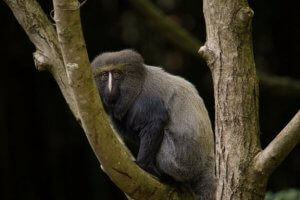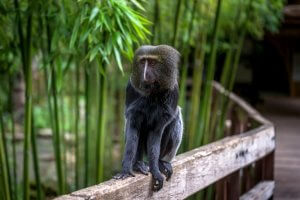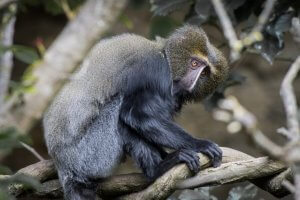Owl-Faced Monkey: Characteristics and Habitat

There are so many different species of ape, but would you imagine one that has features that resemble a bird? This is the case with the owl-faced monkey that — just as its name implies — has a face that makes them look like a feathered nocturnal creature.
Meet the owl-faced monkey
The Cercopithecus hamlyni, also known as the owl-faced monkey, belongs to the Cercopithecus family. It lives in the tropical forests of Eastern Africa. These animals are found in:
- The Democratic Republic of the Congo
- Northwestern Rwanda
- Southwestern Uganda
They live at elevations between 900 and 4600 meters, mainly in bamboo forests, which is their main food source.
However, man also brought this species to other continents. In fact, a Hamlyn monkey first appeared in the London zoo after a merchant brought it over in 1907.
We want to show you the owl-faced monkey, an ape with a characteristic mark on its face that reminds us of nocturnal birds.

Traits of Cercopithecus hamlyni
But what is it about these apes that remind us of owls? The answer is that they have two stripes on their face, one vertical and one horizontal, that form a T. These peculiar markings have a white or yellowish color and stand out against their dark fur. Other physical traits of this primates are:
- Males weigh between 7 and 10 kilograms and females weigh between 4.5 and 6 kilos.
- The body length of the males is between 50 and 65 centimeters and the females’ is between 40 and 55 centimeters.
- They have gray and black, long, dense and thin hair.
The behavior of this ape
The owl-faced monkey is known to be terrestrial and arboreal. However, they prefer to be on the ground when moving around and finding food.
Bamboo is their main food source. But they also eat leaves from other trees as well as herbs, fruits, and seeds.
They live in small groups of no more than 10 individuals. Within these groups, there’s a dominate male that stands out and communicates in both an olfactory and vocal manner. Also, they use a gland in their thorax to mark their territory. Also, they use different voices to orientate themselves or when mating.
This primate’s birthing season is between May and October. The gestation period lasts around five or six months, and then the baby is born. Generally, the female won’t become pregnant again for another two years.

An animal that breeds in zoos
In captivity, the owl-faced monkey can live up to 27 years. Leopards, golden cats and humans are their natural predators in the wild.
However, although their dark fur helps them go unnoticed, deforestation, hunting and low birth rates have made it a vulnerable species. This is according to their qualification by the IUCN (International Union for the Conservation of Nature).
This animal can breed in captivity, and this happens in many zoos in Europe and North America.
[featured-post url=”https://myanimals.com/fongoli-chimpanzees-with-spears/”
There are so many different species of ape, but would you imagine one that has features that resemble a bird? This is the case with the owl-faced monkey that — just as its name implies — has a face that makes them look like a feathered nocturnal creature.
Meet the owl-faced monkey
The Cercopithecus hamlyni, also known as the owl-faced monkey, belongs to the Cercopithecus family. It lives in the tropical forests of Eastern Africa. These animals are found in:
- The Democratic Republic of the Congo
- Northwestern Rwanda
- Southwestern Uganda
They live at elevations between 900 and 4600 meters, mainly in bamboo forests, which is their main food source.
However, man also brought this species to other continents. In fact, a Hamlyn monkey first appeared in the London zoo after a merchant brought it over in 1907.
We want to show you the owl-faced monkey, an ape with a characteristic mark on its face that reminds us of nocturnal birds.

Traits of Cercopithecus hamlyni
But what is it about these apes that remind us of owls? The answer is that they have two stripes on their face, one vertical and one horizontal, that form a T. These peculiar markings have a white or yellowish color and stand out against their dark fur. Other physical traits of this primates are:
- Males weigh between 7 and 10 kilograms and females weigh between 4.5 and 6 kilos.
- The body length of the males is between 50 and 65 centimeters and the females’ is between 40 and 55 centimeters.
- They have gray and black, long, dense and thin hair.
The behavior of this ape
The owl-faced monkey is known to be terrestrial and arboreal. However, they prefer to be on the ground when moving around and finding food.
Bamboo is their main food source. But they also eat leaves from other trees as well as herbs, fruits, and seeds.
They live in small groups of no more than 10 individuals. Within these groups, there’s a dominate male that stands out and communicates in both an olfactory and vocal manner. Also, they use a gland in their thorax to mark their territory. Also, they use different voices to orientate themselves or when mating.
This primate’s birthing season is between May and October. The gestation period lasts around five or six months, and then the baby is born. Generally, the female won’t become pregnant again for another two years.

An animal that breeds in zoos
In captivity, the owl-faced monkey can live up to 27 years. Leopards, golden cats and humans are their natural predators in the wild.
However, although their dark fur helps them go unnoticed, deforestation, hunting and low birth rates have made it a vulnerable species. This is according to their qualification by the IUCN (International Union for the Conservation of Nature).
This animal can breed in captivity, and this happens in many zoos in Europe and North America.
[featured-post url=”https://myanimals.com/fongoli-chimpanzees-with-spears/”
All cited sources were thoroughly reviewed by our team to ensure their quality, reliability, currency, and validity. The bibliography of this article was considered reliable and of academic or scientific accuracy.
Easton, J., Chao, N., Mulindahabi, F., Ntare, N., Rugyerinyange, L., & Ndikubwimana, I. (2011). Status and conservation of the only population of the Vulnerable owl-faced monkey Cercopithecus hamlyni in Rwanda. ORYX. https://doi.org/10.1017/S0030605310001468
This text is provided for informational purposes only and does not replace consultation with a professional. If in doubt, consult your specialist.








